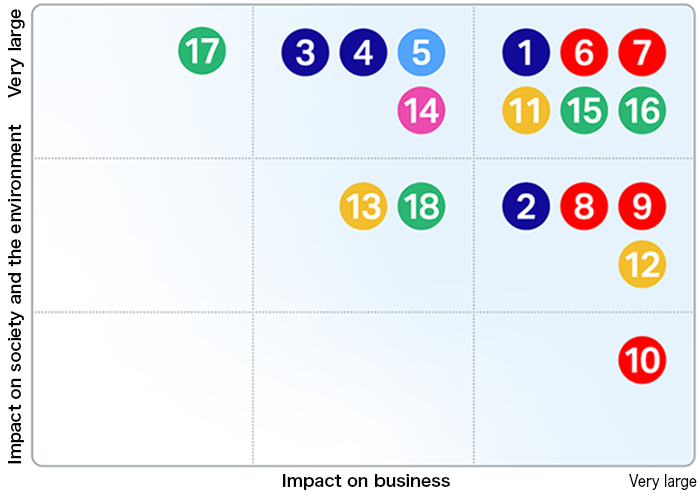Komatsu positions the resolution of social issues through business activities as our fundamental stance under the Sustainability Policy.
We have reviewed the material issues our company should address as follows and identified 18 items across six areas.
Komatsu positions the creation of new customer value, based on our purpose, as the foundation for generating a positive cycle of solving social issues and improving profitability. This approach serves as the core concept of the Strategic Growth Plan to achieve sustainable growth. With the formulation of our new Strategic Growth Plan, we reviewed our materialities for the first time in three years with regard to the issues for our company to address.
The review adopted the concept of double materiality, which evaluates both financial impact and environmental and social impact. Komatsu analyzed business impact and environmental and social impact, defining 18 materialities across six areas. We also incorporated these items in the priority initiatives of the new Strategic Growth Plan announced in April 2025.
Going forward, Komatsu will undertake regular materiality analyses and reflect the identified sustainability-related business risks and opportunities in management initiatives to respond flexibly to changes in the operating and management environment.
Komatsu followed the processes to revise and identify our materialities with support from the Business for Social Responsibility (BSR; a U.S.-based NPO), as a third-party aid.
We compiled a list of 39 items based on past materiality analyses, international targets and standards, reporting frameworks, management philosophy and strategies, and stakeholder materiality.
We interviewed 26 internal and external stakeholders regarding the identified sustainability issues. We then evaluated and mapped these issues based on qualitative input from the interviews, public Komatsu disclosures, and general risk information. Our evaluations incorporated social and environmental perspectives, as well as business perspectives, to map issues based on their potential impact and likelihood.
Based on the evaluation results, we identified 18 materialities with a particularly large impact across six areas: employees, human rights, customers, ethics and governance, communities, and the environment.
We confirmed the alignment of the identified materialities with our Sustainability Policy and the SDGs. The Board of Directors then approved these items, which we positioned in the Strategic Growth Plan as issues to address in pursuit of sustainable growth through a positive cycle of solving social issues and improving profitability.
We also established key performance indicators (KPIs) to ensure steady execution of materiality initiatives. We will disclose progress on these KPIs in the Komatsu Report.

| ●Employees |
❶Occupational safety and health, well-being ❷Talent acquisition, skills development, retention ❸Fair labor practices ❹D&I |
|---|---|
| ●Human rights |
❺Respect for human rights |
| ●Customers |
❻Customer value creation through workplace optimization ❼Product safety and quality ❽Value chain continuity ❾AI and DX ❿Business strategy to ensure competitive edge and profitability |
| ●Ethics and governance |
⓫Privacy and data protection, cybersecurity ⓬Governance aligned with business changes ⓭Compliance |
| ●Communities |
⓮Contribution to local communities |
| ●Environment |
⓯Climate change ⓰Resource circulation ⓱Nature positive ⓲Preserving forests through business activities |